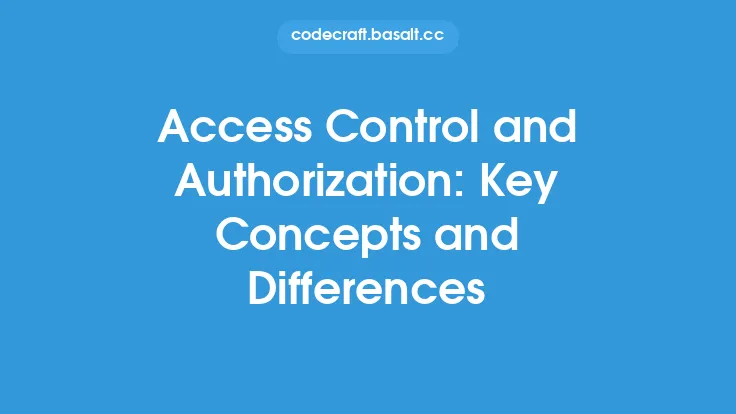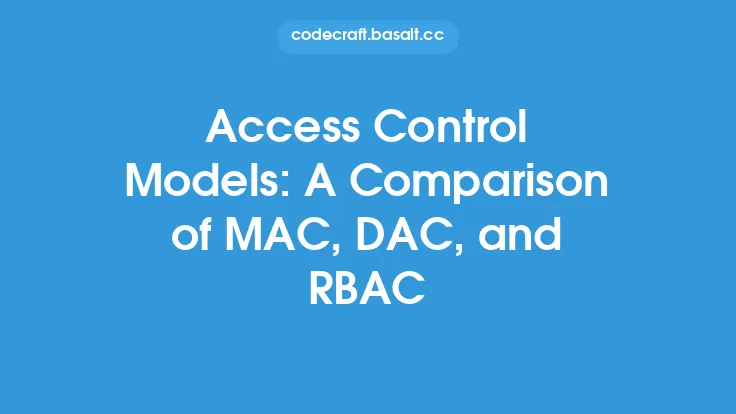Attribute-Based Access Control (ABAC) is a security approach that grants or denies access to resources based on a set of attributes associated with the user, the resource, and the environment in which the access request is made. This approach provides a more fine-grained and flexible access control mechanism compared to traditional access control models such as Discretionary Access Control (DAC) and Mandatory Access Control (MAC). In ABAC, access decisions are made by evaluating a set of attributes, which can include user attributes, resource attributes, and environmental attributes.
Introduction to Attribute-Based Access Control
ABAC is based on the concept of attributes, which are characteristics or properties of the user, resource, or environment. These attributes can be used to define access control policies that are more precise and adaptable to changing circumstances. For example, a user's attribute might include their job function, department, or clearance level, while a resource's attribute might include its classification, ownership, or location. Environmental attributes might include the time of day, location, or network zone. By evaluating these attributes, ABAC systems can make access decisions that are based on a more comprehensive understanding of the access request.
Key Components of Attribute-Based Access Control
There are several key components that make up an ABAC system. These include:
- Policy Administration Point (PAP): This is the component responsible for creating, managing, and storing access control policies. The PAP is used to define the rules and attributes that will be used to make access decisions.
- Policy Decision Point (PDP): This component evaluates the access request against the policies defined in the PAP. The PDP collects the relevant attributes from the user, resource, and environment, and then makes an access decision based on these attributes.
- Policy Enforcement Point (PEP): This component is responsible for enforcing the access decision made by the PDP. The PEP can be integrated into various systems and applications to control access to resources.
- Attribute Authority: This component is responsible for managing and providing attributes to the PDP. The Attribute Authority can include directories, databases, or other systems that store user, resource, and environmental attributes.
How Attribute-Based Access Control Works
The ABAC process involves several steps:
- Request: A user requests access to a resource.
- Attribute Collection: The PDP collects the relevant attributes from the user, resource, and environment. These attributes are used to make the access decision.
- Policy Evaluation: The PDP evaluates the access request against the policies defined in the PAP. The policies are based on the attributes collected in the previous step.
- Access Decision: The PDP makes an access decision based on the policy evaluation. If the access request is granted, the PEP allows access to the resource. If the access request is denied, the PEP blocks access to the resource.
- Audit and Logging: The access decision and any subsequent actions are logged and audited for security and compliance purposes.
Benefits of Attribute-Based Access Control
ABAC provides several benefits over traditional access control models, including:
- Fine-Grained Access Control: ABAC allows for more precise access control decisions based on a wide range of attributes.
- Flexibility: ABAC policies can be easily updated or changed as circumstances change, without requiring significant changes to the underlying infrastructure.
- Scalability: ABAC can handle large numbers of users, resources, and attributes, making it suitable for large and complex organizations.
- Improved Security: ABAC provides a more secure access control mechanism by reducing the risk of over-privilege and under-privilege.
Challenges and Limitations of Attribute-Based Access Control
While ABAC provides several benefits, there are also some challenges and limitations to consider:
- Complexity: ABAC systems can be complex to implement and manage, particularly in large and complex environments.
- Attribute Management: Managing attributes can be challenging, particularly if there are large numbers of attributes to manage.
- Policy Management: Managing ABAC policies can be challenging, particularly if there are large numbers of policies to manage.
- Interoperability: ABAC systems may not be interoperable with all systems and applications, which can limit their effectiveness.
Best Practices for Implementing Attribute-Based Access Control
To implement ABAC effectively, several best practices should be followed:
- Define Clear Policies: Clearly define access control policies based on attributes.
- Manage Attributes Effectively: Manage attributes effectively to ensure that they are accurate and up-to-date.
- Implement Robust Audit and Logging: Implement robust audit and logging mechanisms to track access decisions and any subsequent actions.
- Test and Evaluate: Test and evaluate the ABAC system regularly to ensure that it is working effectively and efficiently.
Future of Attribute-Based Access Control
The future of ABAC is likely to involve increased adoption and use of ABAC systems, particularly in large and complex organizations. There are also likely to be advances in ABAC technology, including the use of artificial intelligence and machine learning to improve the accuracy and efficiency of access control decisions. Additionally, there may be increased focus on interoperability and standards to facilitate the widespread adoption of ABAC systems. As the security landscape continues to evolve, ABAC is likely to play an increasingly important role in providing fine-grained and flexible access control mechanisms.





